Search Results for 'the Connacht Tribune'
37 results found.
A 1927 election rally
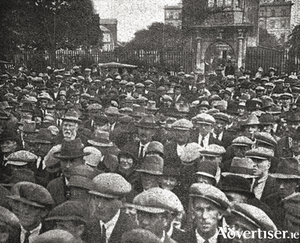
Our photograph was taken on June 5, 1927 from the platform of a Cumann na nGaedheal election rally in Eyre Square. The crowd (almost entirely male), “looked voters every one”. In the background you can see the Browne Doorway and the Railway Hotel.
Two decades on, Galway Early Music festival still brings a wonderful air to the city
Plainchant, medieval song, baroque cello, early brass and harpsichord – a feast of beautiful old music will float across the city as events take place at The 20th Galway Early Music Festival, from May 14-17.
The Augustinian nunnery
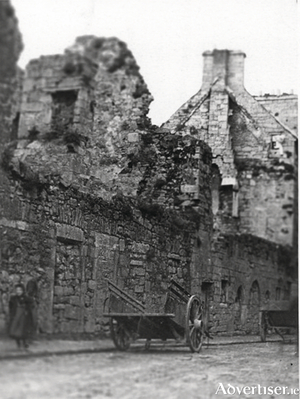
The Augustinian Friars have been in Galway since 1508 when Margaret Athy, whose husband was mayor at the time, built a friary at Forthill, near a spring called St Augustine’s Well, the waters whereof wrought miraculous cures. In O’Flaherty’s Iar-Chonnacht, there is reproduced a document in which a miraculous cure is attested to by the signatures of several witnesses.
Trad night for Pieta House
A night of traditional folk music will take place in The Forge, Moycullen, this Friday, December 5, to raise funds for the Pieta House West facility in Tuam which provides counselling to people who are self-harming or suicidal.
Forty years a-binding, and more to come
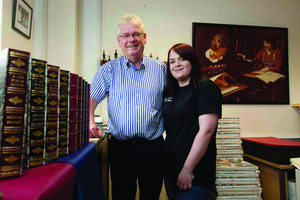
An extraordinary row on the Late Late Show, 17 years ago, had a positive impact on a small Galway business struggling for survival. ‘A very attractive lady,’ Siubhan Maloney, called into Kenny’s Book Bindery, located in Salthill at the time, and told Gerry Kenny that she was a contestant in the Late Late’s Antique Show. She was re-upholstering an old chair, which included a small shelf. She wanted to see how to re-cover an old book in highly decorated leather, which would sit into the shelf. Jerry was happy to show her how it was done. First of all the pages are handsewn together, then clamped and trimmed ready for gold foil, which is applied with heat. This prevents the pages becoming dusty.
From humble beginnings to a digital school of distinction
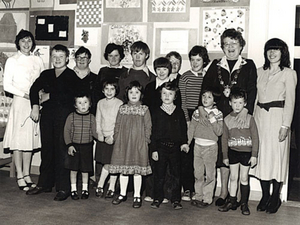
In 1961, Seán Keane, a parent of a child with an intellectual disability, wrote a letter to the Connacht Tribune. He was looking for what all parents want for their children, a chance for them to achieve their full potential whether they be disabled or not. He got no response, so two months later he wrote again, this time a reply to his own letter. The National Association of Mentally Handicapped in Ireland had just been established, it saw the letter and it asked the local Irish National Teachers Organisation in the shape of Mick Raftery and Mícheál McSweeney to call a meeting.
De Burgo’s mansion

This wonderful photograph, dated c1865, shows a carved stone doorway in Market Street, an interesting example of Renaissance work, almost certainly earlier than the Browne Doorway.
Market Street, one hundred years ago
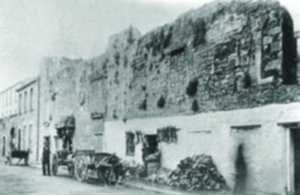
The title of this photograph is ‘Old Building, Market Street’ and it was taken about 100 years ago. The building in the foreground was at one time occupied by the Augustinian nuns who were based in Galway (where the Mechanics is today in Middle Street) before 1651. The last Augustinian nun to die in Ireland is buried in Forthill. These sisters formed part of the same Augustinian Order as the friars, as do their contemplative successors today in countries like Spain and Italy. Continuing persecutions and other historical pressures saw to the end of these nuns in Ireland, though some lingered on in Galway up to the middle of the 19th century.
An Taibhdhearc - becomes ‘pathway to success’

For three years after the opening of the Gate Theatre in Dublin Mícheál MacLiammóir continued to work for An Taibhdhearc. He travelled to Galway as often as three times a week. Despite the Gate's rave reviews for its first play Peer Gynt, for which Mícheál designed its 'symbolic' scenery, money was slow to come in. Mícheál needed the salary that An Taibhdhearc offered. The Minister for Finance, Ernest Blythe (who was soon to take over the running of the Abbey Theatre), and who had taken such interest in the fledgling Galway project, urged its directors to offer MacLiammóir full-time employment. But MacLiammóir felt that his destiny was in Dublin. The Gate opened later in 1928, the same year as An Taibhdhearc, offering Dublin audiences the best of European and American theatre, and rapidly becoming a venue for a new wave of talented Irish writers.
Donnellan’s of Shop Street
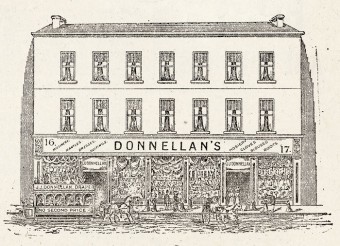
This drawing of the facade of John J Donnellan’s business on Shop Street appeared in the Connacht Tribune of April 9, 1910. The accompanying text said: “Ladies and Gentlemen, I say you cannot do better than call at Donnellan’s, the popular Drapery House for your millinery, your mantles, your blouses, your dresses. Men, for your suitings, your outfittings etc. All goods marked one price – The Lowest. All departments crammed full with the latest novelties”.

